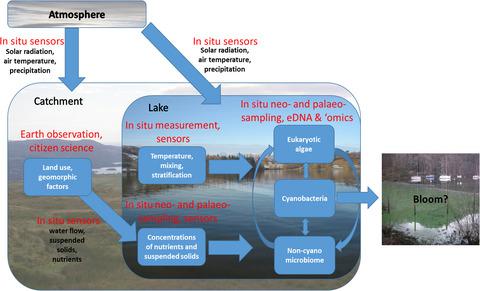当前位置:
X-MOL 学术
›
Glob. Change Biol.
›
论文详情
Our official English website, www.x-mol.net, welcomes your
feedback! (Note: you will need to create a separate account there.)
The case for research integration, from genomics to remote sensing, to understand biodiversity change and functional dynamics in the world's lakes.
Global Change Biology ( IF 10.8 ) Pub Date : 2020-03-29 , DOI: 10.1111/gcb.15045 Stephen J Thackeray 1 , Stephanie E Hampton 2
Global Change Biology ( IF 10.8 ) Pub Date : 2020-03-29 , DOI: 10.1111/gcb.15045 Stephen J Thackeray 1 , Stephanie E Hampton 2
Affiliation

|
Freshwater ecosystems are heavily impacted by multiple stressors, and a freshwater biodiversity crisis is underway. This realization has prompted calls to integrate global freshwater ecosystem data, including traditional taxonomic and newer types of data (e.g., eDNA, remote sensing), to more comprehensively assess change among systems, regions, and organism groups. We argue that data integration should be done, not only with the important purpose of filling gaps in spatial, temporal, and organismal representation, but also with a more ambitious goal: to study fundamental cross-scale biological phenomena. Such knowledge is critical for discerning and projecting ecosystem functional dynamics, a realm of study where generalizations may be more tractable than those relying on taxonomic specificity. Integration could take us beyond cataloging biodiversity losses, and toward predicting ecosystem change more broadly. Fundamental biology questions should be central to integrative, interdisciplinary research on causal ecological mechanisms, combining traditional measures and more novel methods at the leading edge of the biological sciences. We propose a conceptual framework supporting this vision, identifying key questions and uncertainties associated with realizing this research potential. Our framework includes five interdisciplinary "complementarities." First, research approaches may provide comparative complementarity when they offer separate realizations of the same focal phenomenon. Second, for translational complementarity, data from one research approach is used to translate that from another, facilitating new inferences. Thirdly, causal complementarity arises when combining approaches allows us to "fill in" cause-effect relationships. Fourth, contextual complementarity is realized when together research methodologies establish the wider ecological and spatiotemporal context within which focal biological responses occur. Finally, integration may allow us to cross inferential scales through scaling complementarity. Explicitly identifying the modes and purposes of integrating research approaches, and reaching across disciplines to establish appropriate collaboration will allow researchers to address major biological questions that are more than the sum of the parts.
中文翻译:

从基因组学到遥感研究整合的案例,以了解世界湖泊中的生物多样性变化和功能动态。
淡水生态系统受到多重压力的严重影响,淡水生物多样性危机正在进行中。这一认识促使人们呼吁整合全球淡水生态系统数据,包括传统的分类学和较新类型的数据(例如eDNA,遥感),以便更全面地评估系统,区域和生物体之间的变化。我们认为,应该进行数据集成,这不仅要以填补空间,时间和有机体表示的空白为重要目的,而且还要以更雄心勃勃的目标为基础:研究基本的跨尺度生物学现象。这些知识对于辨别和预测生态系统功能动力学至关重要,这是一个研究领域,在此领域中,泛化可能比依赖分类学特异性的泛化更为容易。整合可以使我们超越对生物多样性损失进行分类的范围,而可以更广泛地预测生态系统的变化。基本生物学问题应该是因果生态机制的综合,跨学科研究的中心,应结合传统方法和生物科学前沿的更多新颖方法。我们提出了一个支持这一愿景的概念框架,确定了与实现这一研究潜力相关的关键问题和不确定性。我们的框架包括五个跨学科的“互补性”。首先,当研究方法提供相同焦点现象的单独实现时,它们可能会提供比较互补性。其次,对于翻译的互补性,一种研究方法的数据用于翻译另一种研究方法的数据,以促进新的推论。第三,因果互补性出现在组合方法允许我们“填充”因果关系时。第四,当研究方法共同建立更广泛的生态和时空环境时,就会实现情境互补,在此环境中会发生重要的生物学反应。最后,整合可能使我们能够通过规模互补来跨推论规模。明确确定整合研究方法的模式和目的,并跨学科建立适当的合作关系,将使研究人员能够解决主要的生物学问题,而不仅仅是部分的总和。当研究方法共同建立更广泛的生态和时空环境时,就会实现环境互补,在这种环境中会发生重要的生物学反应。最后,整合可能使我们能够通过规模互补来跨推论规模。明确确定整合研究方法的模式和目的,并跨学科建立适当的合作关系,将使研究人员能够解决主要的生物学问题,而不仅仅是部分的总和。当研究方法共同建立更广泛的生态和时空环境时,就可以实现环境互补,在这种环境中会发生重要的生物学反应。最后,整合可能使我们能够通过规模互补来跨推论规模。明确确定整合研究方法的模式和目的,并跨学科建立适当的合作关系,将使研究人员能够解决主要的生物学问题,而不仅仅是部分的总和。
更新日期:2020-02-19
中文翻译:

从基因组学到遥感研究整合的案例,以了解世界湖泊中的生物多样性变化和功能动态。
淡水生态系统受到多重压力的严重影响,淡水生物多样性危机正在进行中。这一认识促使人们呼吁整合全球淡水生态系统数据,包括传统的分类学和较新类型的数据(例如eDNA,遥感),以便更全面地评估系统,区域和生物体之间的变化。我们认为,应该进行数据集成,这不仅要以填补空间,时间和有机体表示的空白为重要目的,而且还要以更雄心勃勃的目标为基础:研究基本的跨尺度生物学现象。这些知识对于辨别和预测生态系统功能动力学至关重要,这是一个研究领域,在此领域中,泛化可能比依赖分类学特异性的泛化更为容易。整合可以使我们超越对生物多样性损失进行分类的范围,而可以更广泛地预测生态系统的变化。基本生物学问题应该是因果生态机制的综合,跨学科研究的中心,应结合传统方法和生物科学前沿的更多新颖方法。我们提出了一个支持这一愿景的概念框架,确定了与实现这一研究潜力相关的关键问题和不确定性。我们的框架包括五个跨学科的“互补性”。首先,当研究方法提供相同焦点现象的单独实现时,它们可能会提供比较互补性。其次,对于翻译的互补性,一种研究方法的数据用于翻译另一种研究方法的数据,以促进新的推论。第三,因果互补性出现在组合方法允许我们“填充”因果关系时。第四,当研究方法共同建立更广泛的生态和时空环境时,就会实现情境互补,在此环境中会发生重要的生物学反应。最后,整合可能使我们能够通过规模互补来跨推论规模。明确确定整合研究方法的模式和目的,并跨学科建立适当的合作关系,将使研究人员能够解决主要的生物学问题,而不仅仅是部分的总和。当研究方法共同建立更广泛的生态和时空环境时,就会实现环境互补,在这种环境中会发生重要的生物学反应。最后,整合可能使我们能够通过规模互补来跨推论规模。明确确定整合研究方法的模式和目的,并跨学科建立适当的合作关系,将使研究人员能够解决主要的生物学问题,而不仅仅是部分的总和。当研究方法共同建立更广泛的生态和时空环境时,就可以实现环境互补,在这种环境中会发生重要的生物学反应。最后,整合可能使我们能够通过规模互补来跨推论规模。明确确定整合研究方法的模式和目的,并跨学科建立适当的合作关系,将使研究人员能够解决主要的生物学问题,而不仅仅是部分的总和。











































 京公网安备 11010802027423号
京公网安备 11010802027423号